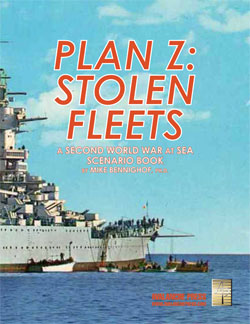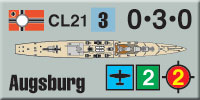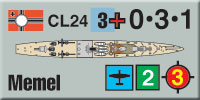| Stolen Fleets:
Captured French Light Cruisers & Aircraft Carriers
by Mike Bennighof, Ph.D.
February 2020
 In the years immediately after the Great War, France’s Marine Nationale approved its first naval construction program since before the conflict. Project 171 included six light cruisers and one aircraft carrier, along with torpedo craft. This formula would be the new model for a revived Young School - since France could no longer build battleships due to treaty restrictions and financial exhaustion, she would project power with cruisers and carriers instead. In the years immediately after the Great War, France’s Marine Nationale approved its first naval construction program since before the conflict. Project 171 included six light cruisers and one aircraft carrier, along with torpedo craft. This formula would be the new model for a revived Young School - since France could no longer build battleships due to treaty restrictions and financial exhaustion, she would project power with cruisers and carriers instead.
That initial class of six light cruisers would be cut to three, and through the 1920’s and early 1930’s France built one more light cruiser to a new design (plus a training cruiser) while concentrating on heavy cruiser construction. The aircraft carrier project began design work soon after the end of the Great War.
The battleship Béarn had been laid down in January 1914 as one of five sisters, with work suspended in August of that year. When the war ended, the French were left with five rusting hulls, laid down for a design that was well behind the state of the art in 1914, let alone in 1919. The Marine Nationale chose to complete Béarn as an aircraft carrier and demolish the other four ships, using parts and materials from them to complete the carrier. Under the terms of the Washington naval agreement she counted as an experimental carrier, leaving France allowed to build two front-line ships.
In our Plan Z alternative history, the fate of those older ships follows that of our actual history: overseas at the time of France’s surrender, they avoid handover to the Germans and join the Free French cause. It’s the new ships that serve the Germans in Plan Z: Stolen Fleets. Let’s have a look at them.
The Class of Six

France built six light cruisers of the La Galissonniére class, laying down two of them in 1931 and four more in 1933. The design drew a great deal of inspiration from the heavy cruiser Algérie in hull form, protection and bridge structure. They carried nine six-inch guns in three triple turrets, eight 90mm heavy anti-aircraft guns, four torpedo tubes and a large array of light anti-aircraft weapons all on a displacement of 7,600 tons. They could make 31 knots on 84,000 horsepower, which seems rather slow for that much power crammed into a small hull.
All six cruisers were at Mers-el-Kebir during the July 1940 British attack, but none were damaged, Afterwards, three of the went to French West Africa, and the other three to Toulon. There they were scuttled in November 1942 with the rest of the Toulon fleet.
Those ships - La Galissonniére herself, Jean de Vienne and Marseillaise - are instead handed over to the Germans in November 1942, still intact. They carried the 152mm (6-inch) Model 1930 as their main armament, the same gun used on the Richelieu class in dual-purpose mounts. The cruiser guns were only intended for use against surface targets, and served in that role far more successfully. They’re retained by the Germans, who replace the 90mm anti-aircraft guns with German 88mm weapons but keep the 40mm Bofors guns since the Germans use these as well (the Swedes happily selling to all sides in this war). Their French torpedo tubes give way to German models, as do their electronics and communications gear; they also receive radar. All of the work takes place in Italian shipyards, rather than risk running them into the Atlantic before they’re ready for action.
The New Cruiser

The Marine National laid down the first of a new class of light cruiser in 1939, planning to start two sisters that were never begun. De Grasse would be an enlarged version of La Galissonniére, with the same main armament on a slightly larger hull displacing 8,000 tons. She had the new 100mm anti-aircraft gun, six of them in three twin mounts, and six torpedo tubes. Her power plant could turn over a prodigious 110,000 horsepower, expected to be good for 35 knots.
De Grasse was laid down in November 1938 at the Arsenal de Lorient, and constructions topped in September 1939 when the ship was about 28 percent complete. The Germans captured the hull, and in December 1942 Adolf Hitler ordered her completed as an aircraft carrier; that project ended in February 1943 with no actual work having been done. The French completed De Grasse after the war as an anti-aircraft cruiser.
In our Plan Z story, she’s already complete when the Germans defeat the French, and captured at Lorient with minor damage from sabotage. She’s re-fitted to German standards along the same lines as her near-sister La Galissonniére and enters German service under the name Memel.
In Stolen Fleets we’ve also included her in carrier guise, with a design similar to the planned conversion of the German heavy cruiser Seydlitz. She’s smaller than the German cruiser and not a very capable carrier.
The New Carriers

After studying conversions of heavy cruiser, armored cruiser and ocean liner hulls, the Marine Nationale settled on a new-construction design for its new aircraft carrier. The two-ship Joffre class followed an unusual design, with a massive island structure to starboard and its flight and deck offset to port to balance the weight. Joffre would have displaced 18,000 tons and was built for speed rather than protection, clocking 33 knots (at least, that was the intention) on 120,000 horsepower generated by a set of geared turbines.
Joffre would have had two hangar decks, a full-length hangar below the flight deck (though not offset) and a smaller lower hangar almost exactly half the length of the upper hangar. She was intended to carry 40 aircraft, and the Marine Nationale ordered 81 Grumman G36 planes (an export version of the F4F Wildcat modified to French requirements) for the ships’ fighter component. Joffre did not have a catapult in her design, and the aircraft capacity seems to be based on the hangars alone, without the provision of an American-style deck park. The Royal Navy provided technical assistance, and the French architects corrected a flaw of British carriers, making the hangars roomy enough to allow aircraft maintenance.
Joffre was laid down in November 1938; construction stopped with the outbreak of war when she was 25 percent complete. Her sister Painlevé had not been formally laid down, though the Penhoët yard had begun collecting materials to start. An authorized third sister was cancelled in April 1940.
In our Plan Z alternative history, France falls in the autumn of 1942, when Joffre and Painlevé are fitting out in the Penhoët yard at St. Nazaire and their third sister is still on the slipway. They’re captured by the Germans, but not before the patriotic French shipfitters have opened the seacocks to scuttle them at their piers. With no crew aboard, there’s no opportunity for demolitions.
Having been raised and repaired, they’re then completed to German standards. German anti-aircraft weapons and electronics replace the French models, the ships gain catapults, and they of course now operate a German-made air group. By early 1944 they’re ready for operations as part of the German carrier force.
All of these assumptions rely on a crucial bit of alternative-ness that shouldn’t be overlooked: we’re positing that either the German Navy acquired a land-based air force of its own including fighter squadrons, or the German Air Force leadership chose to defend naval bases. In the actual Second World War, Britain’s Royal Air Force was allowed to bomb German warships almost with impunity, opposed only by Navy-manned anti-aircraft guns. With aircraft carriers (as well as battleships) also on the target menu, British fliers would have been constantly overhead and eager to blast the new ships into pieces. Given the same German Air Force response as occurred in the real world, any such captured ships would have been blown to pieces long before they served the German cause.
You can order Plan Z: Stolen Fleets right here.
Sign up for our newsletter right here. Your info will never be sold or transferred; we'll just use it to update you on new games and new offers.
Mike Bennighof is president of Avalanche Press and holds a doctorate in history from Emory University. A Fulbright Scholar and award-winning journalist, he has published over 100 books, games and articles on historical subjects.
He lives in Birmingham, Alabama with his wife, three children and his dog, Leopold.
|
